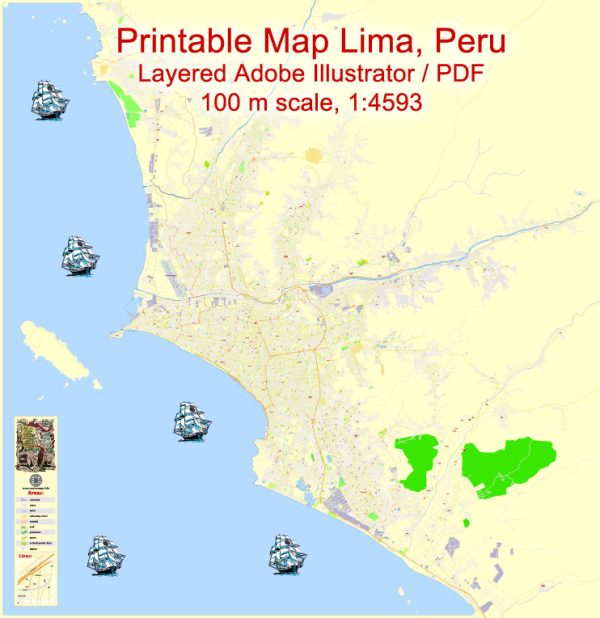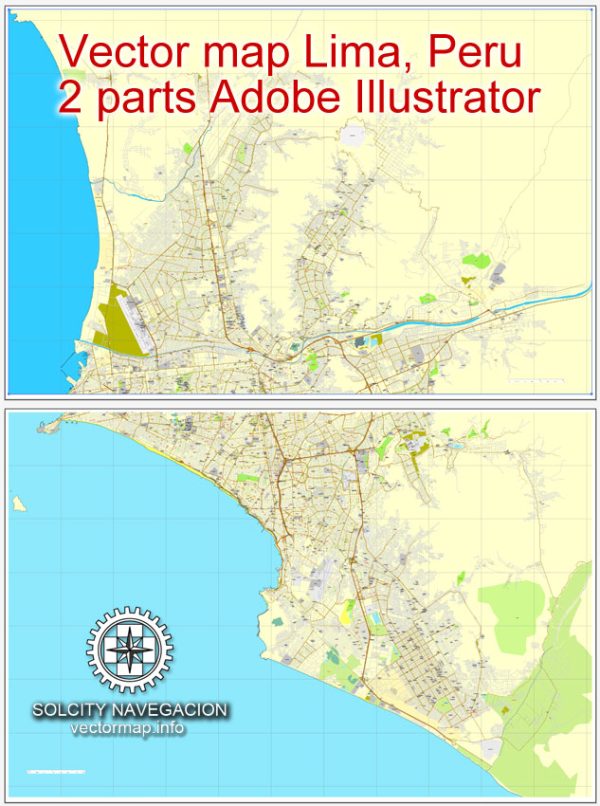Lima is the capital and largest city of Peru, located on the central western coast of the country, along the Pacific Ocean. Vectormap.Net provide you with the most accurate and up-to-date vector maps in Adobe Illustrator, PDF and other formats, designed for editing and printing. Please read the vector map descriptions carefully.
Geography: Lima is situated in the Rimac River valley and is surrounded by the Pacific Ocean to the west and the Andes Mountains to the east. The city covers an area of about 2,672 square kilometers (1,032 square miles).
History: Lima has a rich history that dates back to pre-Columbian times when it was inhabited by various indigenous cultures. In 1535, the Spanish conquistador Francisco Pizarro founded the city of Lima, making it the capital of the Viceroyalty of Peru. Lima played a crucial role in the Spanish colonial administration and later became an important center of trade and culture.
Culture: Lima is known for its cultural diversity, influenced by its indigenous roots, Spanish colonial heritage, and subsequent waves of immigration. The city is home to numerous museums, art galleries, and historic sites that showcase its cultural and historical significance. The historic center of Lima, also known as the “City of Kings,” is a UNESCO World Heritage Site.
Architecture: Lima boasts a mix of architectural styles, including colonial, baroque, neoclassical, and modernist. The historic center features well-preserved colonial-era buildings, including the Cathedral of Lima, the Government Palace, and the Archbishop’s Palace. In contrast, modern districts like Miraflores and San Isidro showcase contemporary architecture, shopping centers, and upscale residential areas.
Economy: Lima serves as the economic hub of Peru, contributing significantly to the country’s GDP. The city is a major center for finance, commerce, and industry, with a diverse economic landscape that includes sectors like mining, manufacturing, and services. Additionally, Lima is known for its culinary scene, with numerous restaurants offering a blend of traditional Peruvian and international cuisine.
Population: Lima is one of the most populous cities in South America. The population is diverse, reflecting the country’s multicultural makeup. It has experienced rapid urbanization and population growth over the years.
Transportation: Lima has a well-developed transportation infrastructure, including an extensive bus network and a growing metro system. The Jorge Chávez International Airport serves as the main gateway for international and domestic flights.
Climate: Lima has a desert climate, characterized by mild temperatures and low precipitation. The city experiences a persistent coastal fog known as the “garúa,” which can bring overcast conditions, especially during the winter months.
Challenges: Like many large cities, Lima faces challenges such as traffic congestion, air pollution, and issues related to urban development. Informal settlements, known as “pueblos jóvenes,” are prevalent on the outskirts of the city, highlighting some of the socioeconomic challenges faced by certain segments of the population.
Lima’s dynamic blend of history, culture, and modernity makes it a fascinating and vibrant city, attracting visitors from around the world. It serves as a gateway to explore the diverse landscapes and cultural heritage of Peru.



 Author: Kirill Shrayber, Ph.D.
Author: Kirill Shrayber, Ph.D.